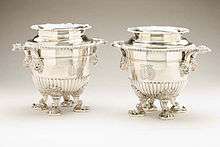Rundell and Bridge
| Industry | Manufacturing |
|---|---|
| Founded | 1787 in London, England |
| Founders | Philip Rundell and John Bridge |
| Headquarters | London, England |
Key people |
|
| Products | goldsmiths' work, jewellery |


Rundell & Bridge were a London firm of jewellers and goldsmiths formed by Philip Rundell (1746–1827)[2] and John Bridge (baptized 1755–1834).[3]
History
When Edmond Waller Rundell, nephew of Philip Rundell, was admitted as a partner in 1804, the firm's name changed to Rundell, Bridge & Rundell.[4] That same year John Gawler Bridge, nephew of John Bridge also joined the firm. Following John Bridge's death in 1834 a new partnership was formed comprising John Gawler Bridge, Thomas Bigge, John Bridge's nephews and Bigge's son, and the firm changed its name to Rundell, Bridge & Co.[5]
The firm was appointed as one of the goldsmiths and jewellers to the king in 1797 and Principal Royal Goldsmiths & Jewellers in 1804, and the firm held the Royal Warrant until 1843.[6]
Amongst its employees were the well-known artists John Flaxman and Thomas Stothard, who both designed and modelled silverware. Directing their workshops from 1802 were the silversmith Benjamin Smith and the designer Digby Scott; and in 1807, Paul Storr, the most celebrated English silversmith of the period, took charge, withdrawing from the firm in 1819 to establish his own workshops.[7]
The Royal Goldsmiths served four monarchs: George III, George IV, William IV and Victoria. In addition, their name was attributed to the 'Rundell tiara', made for Princess Alexandra in 1863. [8]
Works
After the Congress of Vienna (1814-15), the firm prepared 22 snuff-boxes to a value of 1000 guineas each to be given as diplomatic gifts.[9]
General Mining Association
Rundell, Bridge & Rundell formed the General Mining Association (G.M.A.) in 1827 and opened a colliery in Sydney Mines, Cape Breton, Nova Scotia, Canada the same year and a second colliery in nearby Dominion (then called Lingan and subsequently Bridgeport) in 1830. The G.M.A. operated coal mines and built shipping piers and railways in Cape Breton until it sold its eastern Cape Breton County holdings to the Dominion Coal Company by 1894 and retained its Sydney Mines operations until selling to the Nova Scotia Steel and Coal Corporation in 1900.[10]
Bibliography
- Hartop, Christopher, with foreword by HRH The Prince of Wales, introduction by Philippa Glanville and essays by Diana Scarisbrick, Charles Truman, David Watkin and Matthew Winterbottom (2005). Royal Goldsmiths: The Art of Rundell & Bridge 1797-1843 Cambridge: John Adamson ISBN 978-0-9524322-3-4
- Hartop, Christopher (October 2015), Art in Industry: The Silver of Paul Storr, Cambridge: John Adamson ISBN 978-1-898565-14-7
References
| Wikimedia Commons has media related to Rundell and Bridge. |
- ↑ Quotation from a promotional colour print issued by Rundell's of the Imperial Crown, reproduced in Hartop, Royal Goldsmiths, p. 143.
- ↑ See the Wikidata entry for Philip Rundell.
- ↑ See the Wikidata entry for John Bridge.
- ↑ Hartop, Royal Goldsmiths, "Chronology", p. 12.
- ↑ Hartop, Royal Goldsmiths, "Chronology", p. 13.
- ↑ Hartop, Royal Goldsmiths, "Chronology", pp. 12–13.
- ↑ Hartop, Royal Goldsmiths, "Chronology", pp. 12–13.
- ↑ The Rundell Tiara.
- ↑ Marcia Pointon, "Surrounded with brilliants: Miniature portraits in eighteenth century England", The Art Bulletin, Vol. 83, No. 1, (March 2001), pp. 48-71.
- ↑ Charles William Vernon, Cape Breton, Canada, at the Beginning of the Twentieth Century: A Treatise of Natural Resources and Development (Toronto and New York: Nation Publishing Company, 1903), pp. 172–8. Leonard Stephenson, Dominion, NS, 1906-1981, pp. 8–9.
|